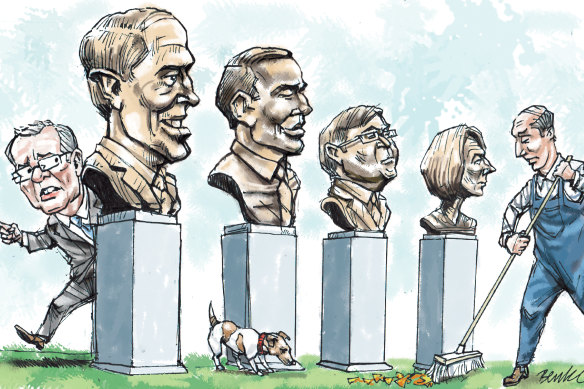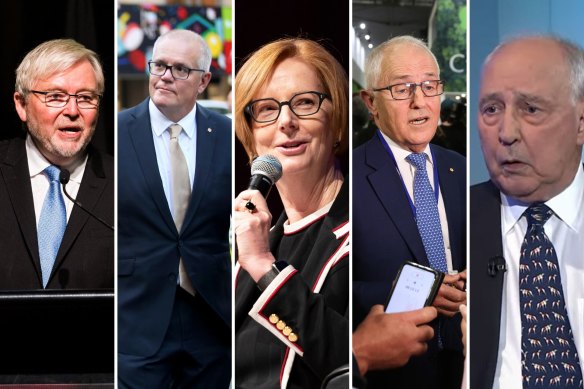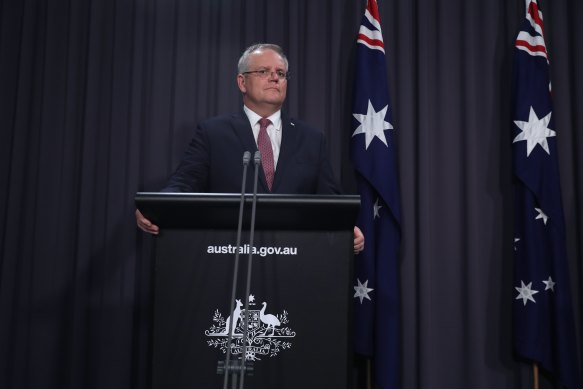There is one thing we could copy from America’s politics. Our ex-PMs prove it

Tis the season of ex-prime ministers. “Julia”, a blistering play climaxing in Julia Gillard’s misogyny speech, has just opened in Sydney. There was the Keating show at the National Press Club in Canberra, more King Lear than Placido Domingo. Kevin Rudd is striding the international boards again in Washington, this time as Australia’s US ambassador.
Malcolm Turnbull has launched a timely new podcast on the need to defend democracy. John Howard has resumed his elder statesman role in seeking to reassure the Liberal Party that it has not reached the end of its run. Scott Morrison seems to be preparing for his exit, stage right naturally.
Illustration by Jozsef Benke.Credit:
Canberra’s appetite for political cannibalism, combined with the electorate occasionally getting the opportunity to weigh in, means there are a lot of ex-prime ministers in circulation. Many have time on their hands and decades left to live. Julia Gillard was aged just 51 when Kevin Rudd executed his revenge ouster. Rudd himself was three days shy of his 56th birthday when he lost the election to Tony Abbott. Small wonder that ex-prime ministers loom so large in national life.
As someone who has spent a large share of his professional life covering the White House, I have always been intrigued at how Australia regards its one-time occupants of The Lodge. Every former US president now gets a presidential library that bears their name, something which would obviously be anathema to Australians. Julia Gillard gets a play. Paul Keating got a musical. Bob Hawke got a craft beer. Harold Holt got a swimming pool. Malcolm Fraser got a bridge. He might even have been venerated with a suburb in Canberra, like more than a dozen other ex-prime ministers, had there not been a Fraser already.
Perhaps the closest thing that Australia has to the National Mall in the District of Columbia, the home to memorials of Washington, Lincoln and Jefferson, is the Prime Ministers’ Avenue, a collection of bronze busts at the Botanical Gardens in Ballarat. You get the picture. Just as Australians rarely put their prime ministers on a pedestal while in office, they don’t place them on a plinth once they have left. The John Curtin and Ben Chifley sculpture in Canberra is deliberately metaphoric. Both have their bronze feet firmly on the ground. Even the country’s longest-serving PM Robert Menzies, whose statue graces the shores of Lake Burley Griffin, is not uplifted.
Canberra’s appetite for political cannibalism means there are a lot of ex-prime ministers in circulation.
How Australia memorialises its ex-prime ministers reveals a lot about public attitudes towards the prestige of the office itself. The preference has been for unshowy leaders who do not push the limits of their power, which partly explains why Anthony Albanese has slipped so comfortably into the role. Indeed, often it feels more like an Albanese administration than an Albanese prime ministership, because of his willingness to share the spotlight with a strong ensemble cast.
But should things be amped up a bit? Should we flick the switch to a bit more prime ministerial vaudeville? Ordinarily I am phobic to importing almost any political influences from the modern-day United States. The American strain of democracy is something to inoculate against, especially when it comes in the form of gallows paraded through the streets of Melbourne or US-style culture wars that are such a political waste of time. However, with those reservations duly noted, I do think that the Australian prime ministership could be fractionally more presidential.
Here, I’m not talking about elongated motorcades or a Morrison-style executive power grab. Rather I would propose some smallish changes to boost the prestige more so than the power of the office.
As I have written in these pages before, I think the country would benefit from the prime minister of the day delivering an annual state of the nation address, which would displace dreary old budget night as the showpiece parliamentary event of the year. I would reduce prime ministerial participation in Question Time during sitting weeks, a largely theatrical undertaking rather than an exercise in accountability, and make it bi-weekly rather than every day.
A storage room for flags: The Blue Room at Parliament House.Credit: Mike Bowers/Guardian Australia pool
Major policy announcements could sometimes benefit from grander settings than the “Blue Room” in Parliament House, which has the feel of a storage room for flags. Would not the unveiling of the wording for the Voice referendum have felt more momentous had it been delivered in a more iconic setting which made reference to country and land? A backdrop like Uluru would have provided a visual reminder of the high historic stakes of the Voice referendum. Mere symbolism, I hear you cry. But as Gough Whitlam demonstrated almost fifty years ago when he poured red soil into the hand of the Gurindji elder Vincent Lingiari, symbolism is so often so important.
Personally, I would banish fluorescent jackets from the prime ministerial wardrobe, or at least heavily restrict their use. Why, when some cash eventually frees up, I would even look into providing the prime minister with some new digs and turn The Lodge into a museum. For a fraction of the cost of a periscope, a brilliant homegrown architect could design a new prime ministerial abode which could showcase how contemporary Australian residential architecture is arguably the best in the world.
Here I realise I am wading into a field of poppies, in which the Australian electorate has a habit of scything down prime ministers with ideas above their station. But during an era when Australia has struggled sometimes to enact even incremental reforms, a bigger prime ministership might lead to some bolder national thinking.
The Opinion newsletter is a weekly wrap of views that will challenge, champion and inform your own. Sign up here.
Most Viewed in Politics
From our partners
Source: Read Full Article


